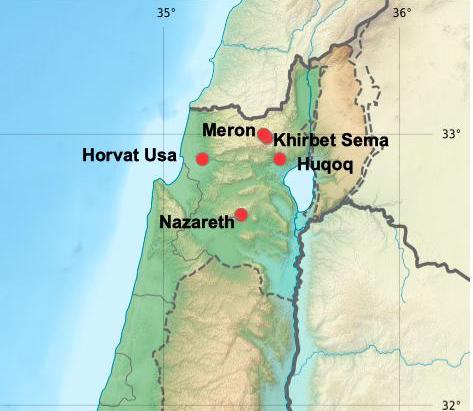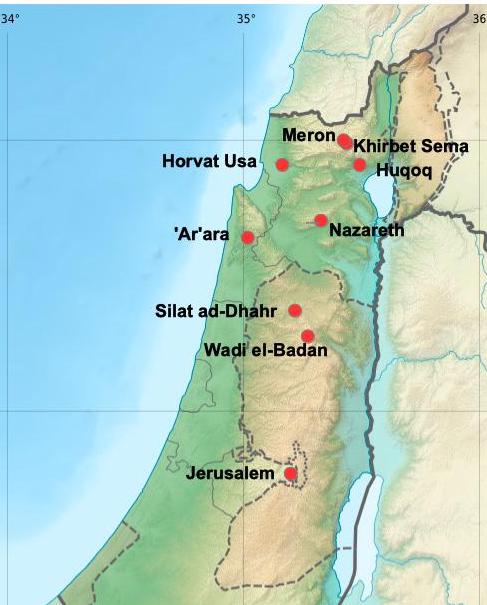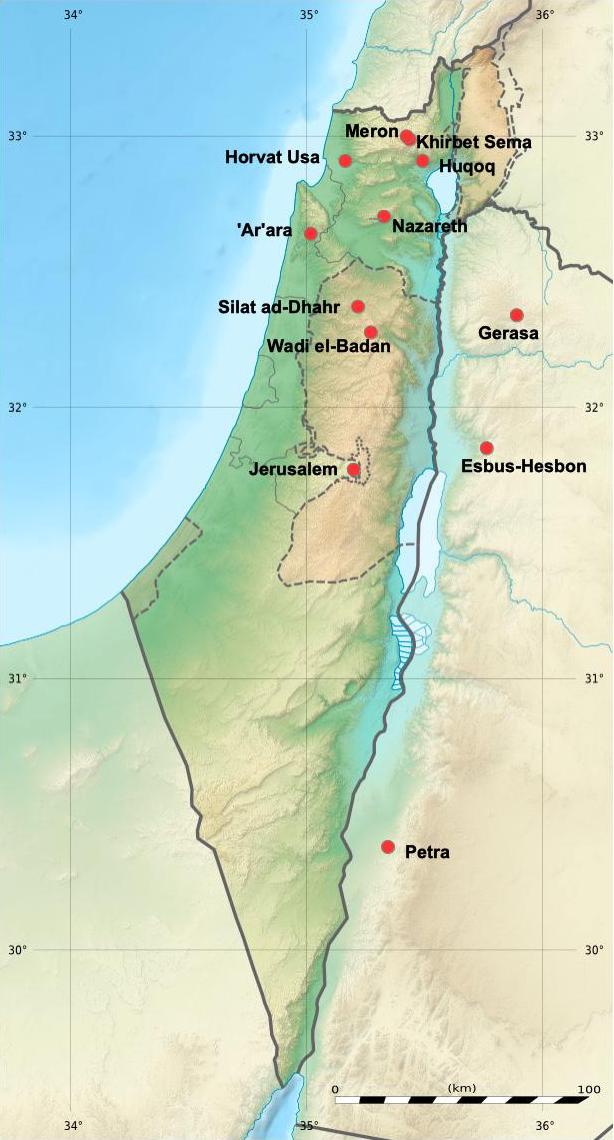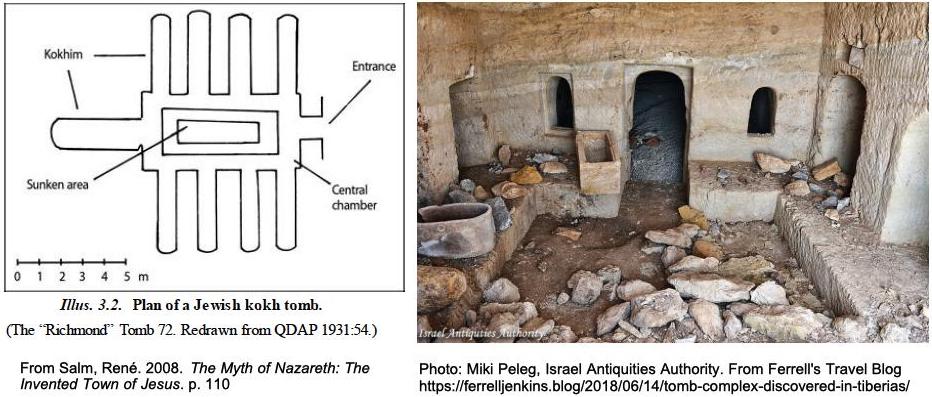Having finally caught up with Tim O’Neill’s October 2019 post on his History for Atheists blog, JESUS MYTHICISM 5: THE NAZARETH “MYTH”, I have decided to address a new point he makes since I last responded to his Nazareth assertions. Most of his October post is a rehash of what I demonstrated was erroneous in More Nazareth Nonsense from Tim O’Neill. But he has added a new point in an apparent attempt to refute at least one key part of my original criticism and it is that new point that I address here.
I have invited Tim O’Neill to discuss his criticisms on condition that he refrain from abuse and insult. He has responded by declaring I am not worth engaging with because I resort to “nitpicking”, otherwise known as “fact-checking”. Perhaps he will see this post as another example of “nitpicking”, this time in response to his claim that René Salm has based a key part of his argument on a mistranslation of a single sentence in Hans-Peter Kuhnen’s Palästina in griechisch-römischer Zeit.
What is the relevance of all this to the Nazareth debate?
Salm argues that there is no secure archaeological evidence published in the scholarly literature that enables us to date a settlement in Nazareth at the time of Jesus. The evidence for a settlement in Roman times only begins to appear from the mid or late first century CE. If the kokh tombs around Nazareth could be dated to the early first century then there would be a reasonable case for Nazareth being occupied at that time.
Kokh tombs were known around the Jerusalem region long before and during the time of Christ but Salm insists that they did not appear in Galilee until towards the end of the first century.
Salm has used Kuhnen’s work to argue that it is a mistake to use the dates of Jerusalem sites for the Galilee region. The kokh tombs appeared in Galilee much later than they did around Jerusalem, he says.
What is a kokh tomb?
O’Neill’s new point
Here is the section of Tim O’Neill’s rebuttal of René Salm’s argument that I want to address.
Kokhim of this kind date from as early as 200 BC, but Salm insists that while they were used this early elsewhere in Palestine, they only came to be used in Galilee much later. For this he depends heavily on a single quote from German archaeologist Hans-Peter Kuhnen in his Palästina in griechisch-römischer Zeit (München: C.H. Beck, 1990). There Kuhnen discusses the origin and spread of kokhim in Palestine, appearing under the Hasmoneans and coming to dominate the style of tombs around Jerusalem by the time of Herod. He goes on to say (in Salm’s translation):
Apparently only later, from approximately the middle of the first century after Christ, did people begin to build kokh tombs in other upland regions of Palestine, as seen in Galilee at Huqoq, Meron, H. Serna and H. Usa. (Kuhnen, p. 254, in Salm, p.159)
Salm concludes from this that “kokh tomb use spreads to Galilee only after c. 50 CE” (p. 159), which he feels pushes the dates of the tombs in the Nazareth valley safely away from the period his theory needs to avoid.
But Kuhnen does not say that they did not reach Galilee until around the mid century: he specifies the “mountain regions of Palestine” (“Bergregionen Palästinas” in Kuhnen’s original German) and then gives examples of sites from the very north of Upper Galilee, in the mountains close to the modern Lebanon border and far from the lowland region in which Nazareth sits. Salm chooses to ignore where the illustrative examples Kuhnen are, translates “Bergregionen” as “upland” rather than “mountainous regions” or “mountain regions” (because the low-lying Nazareth region is not remotely “mountainous”) and so decides Kuhnen is saying kokhim did not reach Galilee generally – lower or upper – until “c. 50 CE”. Once again, he twists the scholarship and so shapes the evidence to fit his conclusion.
O’Neill, Tim. 2019. “Jesus Mythicism 5: The Nazareth ‘Myth.’” History for Atheists (blog). October 30, 2019. https://historyforatheists.com/2019/10/nazareth-myth/.
(My bolded highlighting of O’Neill’s words that I will show are “misleading” at best.)
O’Neill has only quoted a snippet of Salm’s relevant text and he has even misrepresented Kuhnen’s original passage. I don’t believe O’Neill did either of these things with deliberate dishonesty. I think he is so convinced that Salm is a fraud for daring to question the mainstream biblical scholars that he has only glanced at both Salm’s and Kuhnen’s words and once he thought he saw enough to “prove” his point he looked no further. It is “human” to see what we expect and want to see. He relies upon Salm’s translation of a critical passage so it appears he has not even consulted Kuhnen’s work for himself.
Response #1 — selective quoting
To his credit Salm quotes the original German of the section he translated so readers can hold him to account. Here is Salm’s complete quotation of Kuhnen:
15 Schiebestollengräber, die unter den Hasmonäern allmählich die älteren Kammergräber ersetzt hatten, beherrschten auch nach der Thronbesteigung des Herodes fast mit Ausschliesslichkeit die Friedhöfe der Stadt… Auch im jüdisch besiedelten Umland Jerusalems entstanden unter Herodes und dessen Erben Gräber des Schiebestollentyps, beispielsweise in Tell en-Nasbe und in el-‘Ezariye (Betanien) … Anscheinend noch später, etwa ab der Mitte des 1.Jh. n.Chr., begann man in den anderen Bergregionen Palästinas Gräber mit Schiebestollen anzulegen, was für Galiläa Huqoq, Meron, H. Sema und H. Usa… belegen.
Somit ist anzunehmen, dass Schiebestollengräber während des 1.Jh. n.Chr. in allen Landesteilen westlich und östlich des Jordan in Mode kamen… (Kuhnen 254–55).
(Salm, 159)
Kokh tombs [Schiebestollengräber], which under the Hasmoneans gradually replaced the older chamber tombs, also dominated the graveyards of [Jerusalem] almost with exclusivity after the accession of Herod… Under Herod and his heirs, the kokhi type of grave also appeared in the Jewish-populated surroundings of Jerusalem, for example, in Tell en-Nasbe and in el-‘Ezriye (Bethany)… Apparently only later, from approximately the middle of the first century after Christ, did people begin to build kokh tombs in other upland regions of Palestine, as seen in Galilee at Huqoq, Meron, H. Sema and H. Usa…
So it is evident that during the first century after Christ kokhim came into fashion in all parts of the land west and east of the Jordan…15
(Salm, 159. My bolded highlighting)
O’Neill failed to quote the last sentence Salm translates from Kuhnen which underscores Salm’s reading of Kuhnen’s point: kokh tombs were not known outside the Jerusalem region [i.e. not only in northern Galilee] until around the middle of the first century CE and not before. O’Neill wrongly claimed Salm said the kokh tombs were used everywhere else in Palestine except Galilee in the early first-century thus making his claim look like special pleading. He stopped short of quoting the sentence that flatly contradicted and exposes his misrepresentation of Salm’s argument.
O’Neill further infers that Kuhnen only points to sites in the “very north of Upper Galilee, in the mountains close to the modern Lebanon” that were the late borrowers of kokh tombs. That is flat wrong as we see in Response #2.
Response #2 — ignorance of geography
The four sites listed by Kuhnen are not, contrary to O’Neill’s assertion, “in the mountains close to the modern Lebanon border”. Two of them are; the other two are further south and on lower ground even than Nazareth.
Huqoq — not far from the “Sea” of Galilee, ca 30 metres above sea level
Meron — mountainous region in the far north, ca 600 meters above sea level
Khirbet Sema — mountainous region in the far north, ca 600 meters above sea level
Horvat Usä — further south, approx 8 kilometres east of Acre, about 30 meters above sea level

How “mountainous” is Nazareth by comparison? It is approx 350 meters above sea level.
But O’Neill has apparently not taken the time to consult Kuhnen’s book as Salm obviously did. Salm appears to have absorbed and incorporated Kuhnen’s intent from his larger argument as we shall see.
Response #3 — not only Galilee
We now enter some serious “nitpicking” (“fact-checking”) with a look at the intent and thrust of Kuhnen’s discussion. Salm only quoted the first half of examples Kuhnen provided to illustrate his point about the apparent delay in the spread of kokhim tombs. The other half listed sites south of Galilee — in the region of Samaria.
[only later. . . as seen in] Galilee Huqöq, Merön, H. Sema and H. Usä, for Samaria Samaria-Sebaste, ‘Ar’ara, Sīlet ed-Dahr and Wädi Bedän.
(Kuhnen, 255)
So Kuhnen is saying that the spread of the kokhim tombs spread not only to northern Galilee but to Samaria as well quite some time after they became common around Jerusalem. (For the sake of completeness of comparisons I have added the elevations.)
‘Ar’ara — ca. 150-200 m
Sīlet ed-Dahr / Silat ad-Dhahr — ca 400 m
Wädi Bedän — 200 m
So now the map looks like this and Salm’s point about the kokh tombs appearing in Nazareth well after they were familiar around Jerusalem looks even more reasonable.

In discussing the spread of kokh tombs beyond Jerusalem Kuhnen includes the east as well as the north.
Response #4 — and beyond the Jordan
The next sentence in Kuhnen’s paragraph cites tombs in the Transjordan as being part of that later spread of kokh type tombs. To quote with the assistance of Google Translate:
In Transjordanien sind Schiebestollengräber seit den späteren Nabatäerkönigen faßbar, unter anderem in Gerasa, Esbus-Hesbon und in der Hauptstadt Petra (s.u. S.407f.). . . .
Neben solchen Adaptionen nabatäischen Erbes war seit Traian römischer Einfluß in Petra vorherrschend.
(Kuhnen, 255, 408)
In Transjordan, tunnels for [kokh tombs] have been found since the later Nabataean kings, among others in Gerasa, Esbus-Hesbon and in the capital Petra (see below p. 407f.).
On page 408 Kuhnen informs us
In addition to such adaptations of Nabataean heritage, Roman influence had been predominant in Petra since Trajan.
Trajan reigned in the early second century CE. According to Kuhnen the Roman architectural influence spread across the Jordan from the end of the first century CE.
So now the map is complete with its identification of the sites that were late to see the Jerusalem style of tombs.

Conclusion
I don’t know German and have to let O’Neill’s charge that Salm has mistranslated a word that should have been “mountainous”. However, I can read enough of Kuhnen’s discussion to see from the sites he lists as places where the kokh tombs appeared considerably later than at Jerusalem that he did not mean to say that kokh tombs were only late in high mountain areas of northern Galilee. In that very same sentence he includes two places not much higher than sea level and no closer than the fringes of that mountainous area in Galilee.
By choosing to refer tendentiously to the only two sites that support his argument (ignoring the other two Galilean sites quoted by Salm) while ignoring the other nine sites listed by Kuhnen as part of his case, O’Neill has seriously misrepresented the full argument of Kuhnen and Salm.
One may disagree with Salm’s reasoning but one cannot deny that he has based his thesis on a close and consistent reading of the archaeological evidence as published in the scholarly literature. To effectively rebut Salm’s point one needs to engage with that same literature and his use of it. Ridicule, sarcasm and slap-dash treatments don’t cut it.
From this we see that kokh tomb use begins c. 150 BCE in Jerusalem, comes to prevail in that city after Herod’s accession, and spreads to Galilee only after c. 50 CE.16Thus, M. Aviam has noted that “no Jewish tombs from the Hasmonaean or Early Roman periods have yet been excavated in the Galilee.”17 In all, there is a 200-year delay between the first beginnings of kokh use in Jerusalem and its appearance in Galilee. The delay is even greater if we consider that the first kokhim in Palestine may date as early as III BCE.
We are now able to deal with a false assumption frequently encountered in the Nazareth literature: that the presence of kokh tombs in the basin automatically attests to human presence there in Hellenistic times, or in the time of Christ, or even in Early Roman times. Thus, already in the 1930s, Fr. Clemens Kopp considered the Nazareth tombs to be as early as III BCE18—by comparing them to possibly the earliest kokhim known in Palestine (those at Marisa). His error amounts to no less than three centuries. The same assumption persists even to the present day. For example, in a 1998 German reference article on Nazareth, we read: “Grabfunde bezeugen eine Besiedlung seit dem Ende des 3 Jh. v C”19 Such a view has fueled the false Hellenistic Renaissance doctrine, disproved in Chapter Three.
Similar examples are readily encountered: “Of the twenty-three tombs found c 450 m (500 yd.) from the [Church of the Annunciation] most were of the kokim type… known in Palestine from c 200 BC and which became the standard Jewish type”20 This is true enough yet, as Kuhnen reveals, there is no connection between the kokhim tombs of 200 BCE and those at Nazareth.
Again, in another dictionary article on Nazareth we read: “The location of the tombs of the first century BCE to the first century CE disclose that the occupied area extended hardly 300 by 100 meters.”21 In fact, this is not at all the case. The Galilean kokhim tombs, as we have just seen, were not “of the first century BCE to the first century CE.” We can now say that, at the earliest, the Nazareth tombs date to the latter half of the first century CE. As regards the emplacement of the ancient village, we must defer that interesting question until Chapter Five, when we consider scriptural demands to locate the village on the hillside.
Contrary to the implications found in much Nazareth literature, the many kokhim excavated in the basin are evidence neither of Hellenistic times nor of Early Roman times. Per Kuhnen’s analysis, they postdate 50 CE, and probably 70 CE. A Middle Roman beginning for kokh tombs at Nazareth accords with the dating arrived at from other data in the basin, including pottery, rolling stones, arcosolia, trough graves, and stone vessels.
(Salm, 159-60. My bolding)
And a little “by the way”: contrary the impression one might gain from Tim O’Neill’s accusation that René Salm relies upon a “single sentence” for a critical point of his thesis, Salm in fact makes important use of Hans-Peter Kuhnen’s work several times (pp. 100, 158-64, 269-70) to build up a broader understanding the relevant archaeological evidence. Salm is clearly well informed of the larger discussion Kuhnen presents and has made considerably more use of Palästina in Griechisch-Römischer Zeit than supposedly cherry-picking a single sentence.
Kuhnen, Hans-Peter. 1990. Palästina in Griechisch-Römischer Zeit. München: Beck.
O’Neill, Tim. 2019. “Jesus Mythicism 5: The Nazareth ‘Myth.’” History for Atheists (blog). October 30, 2019. https://historyforatheists.com/2019/10/nazareth-myth/
Salm, René 2008. The Myth of Nazareth: The Invented Town of Jesus. Cranford, N.J: American Atheist Press.
. . . .
The Map
The map I used as the base for marking the archaeological sites is from . . .
- Gaba, Eric [Sting], and NordNordWest. 2011. “Location Map of Israel. De Facto Situation.” Wikimedia Commons. https://commons.wikimedia.org/wiki/File:Israel_relief_location_map.jpg.
See the terms of Vridar’s creative commons for reuse. Check CC link just beneath the title of this post.
Details (including altitudes above sea level) on the ten archaeological sites listed by Kuhnen are taken from Google Earth and Google Maps (I did my best to locate them accurately on the maps in the post) and the following articles:
Huqoq
- Lissovsky, Nurit. 2008. “Hukkok, Yaquq and Habakkuk’s Tomb: Changes over Time and Space.” Palestine Exploration Quarterly 140 (2): 103–18.
Meron
- Meyers, Carol L., Eric M. Meyers, and James F. Strange. 1974. “Excavations at Meiron, in Upper Galilee. 1971, 1972: A Preliminary Report.” Bulletin of the American Schools of Oriental Research, no. 214: 2–25. https://doi.org/10.2307/1356101.
Khirbet Sema
- Meyers, Eric M., A. Thomas Kraabel, and James F. Strange. 1976. “Ancient Synagogue Excavations at Khirbet Shema’, Upper Galilee, Israel 1970-1972.” The Annual of the American Schools of Oriental Research 42: iii–297. https://doi.org/10.2307/3768529.
Horvat Usä
- Ben-Tor, Amnon. 1966. “Excavations at Ḥorvat ʿuṣä.” ’Atiqot: Hebrew Series / עתיקות: סידרה עברית ג’: 1-3.
- Frankel, Rafael. 1988. “Topographical Notes on the Territory of Acre in the Crusader Period.” Israel Exploration Journal 38 (4): 249–72.
Map coordinates for the remaining places were taken from Wikipedia. Google searching enabled me to track down alternative spellings which proved necessary for some of them.
‘Ar’ara — https://en.wikipedia.org/wiki/Ar%27ara
Sīlet ed-Dahr / Silat ad-Dhahr — https://en.wikipedia.org/wiki/Silat_ad-Dhahr
Wädi Bedän / al Badhan — https://en.wikipedia.org/wiki/Al-Badhan
Gerasa / Jerash — https://en.wikipedia.org/wiki/Jerash
Esbus-Hesbon / Heshbon — https://en.wikipedia.org/wiki/Heshbon
Petra — https://en.wikipedia.org/wiki/Petra
If you enjoyed this post, please consider donating to Vridar. Thanks!


Has the material in the tombs been dated by test, not by guess? A few solid C14 dates could settle things.
Unfortunately the bones of the deceased are not there to carbon date, though I don’t think that C14 dating would be precise enough to decide if a burial was early or late first century. The oil lamps, pottery and glassware found in three of the tombs near Nazareth are not amenable to C14 testing. They have been dated on the basis of style as early as the first century by some but that is another controversial discussion.
I fee the argument of the kokh tomb dating being evidence of a made up town of Nazareth before its time is only sound if it can also be demonstrated that:
Tombs or burials of other types were NOT around at the time or before the kokh tombs.
It also appears the kokh tomb is technology reliant, i.e. tooling, skills, but also geography reliant in the sense that not all ground formations would be suitable for them. If such tombs became common later in Nazareth it may only reflect a gradual urban agglomeration of the town that existed before, but in a more primitive form without such elaborate tombs.
I’ve been asking if there is any evidence of Nazareth exiting 5 BC. O’Neill and apologists keep telling me about “early Roman period blah blah blah…” and nothing can be dated around 5 BC, but somehow they are sure it existed 5 BC. O’Neill even call me a “fanatic” when repeatedly I asked for evidence he couldn’t provide…
Name-calling is a standard response for those who can do nothing more than rely upon the assertions of the authorities. (I was recently expelled from a Facebook discussion group for actually questioning the claim that rebels and bandits mentioned by Josephus were seen as messianic figures. I kept asking for evidence and appealing to my interlocutor to read the lastest history by Steve Mason. That was an intolerable insistence, in their eyes.)
O’Neil leans on the stone marker about Naz and priests coming from Nazareth. But from Josephus we get Gophna. Not sure the cite for Bar Kokhba
The Roman emperor Vespasian occupied the town in 68 CE, established an army garrison there, and concentrated within the city Jewish priests and other local notables who had surrendered to him.[6][16] Titus, the future Roman emperor, passed through Gophna during his march to besiege Jerusalem in 70 CE.[17] Gophna had a sizable priestly Israelite population on the wake of the Bar Kokhba Revolt in the 130s, and it is possible that an entire synagogue congregation of Gophna (including priests) relocated to Sepphoris in Galilee by the 3rd century CE.[18]https://en.wikipedia.org/wiki/Jifna
Tim O’Neil is an aggressive arrogant, which basically completely prevents any substantive discussion with him. Greetings from the regular reader from Poland.
Yes, which happily for him has the effect of avoiding being put in a position where he can be called to account in a serious scholarly discussion. Cheers to Poland! (Though I worry a little about what I read in the news about your part of the world.)
I’d like Tim O’Neil to explain how those kokhim tombs (that were dated post 50 CE) were found directly under the house that Mary supposedly lived in the early part of the first century. Very well researched article Mr Godfrey!